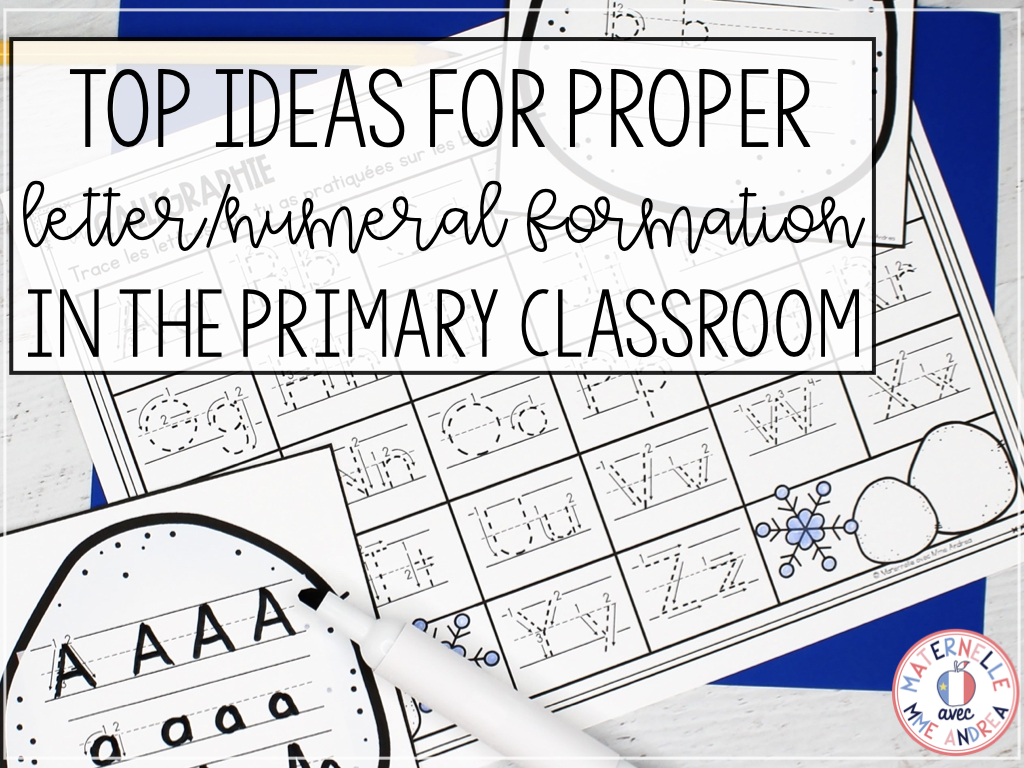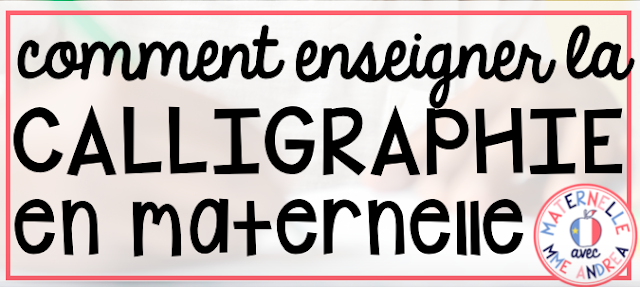Let’s take a second and talk about one of my biggest nemesis today… proper letter/numeral formation!
My students have SUCH a hard time writing top to bottom, right to left.
They always seem to come to me (in maternelle or in première année) writing in the most inefficient ways… like making five different movements to write the number 4, for example (that’s an example from this year in grade one haha).
Or, they will insist on telling me that they counted “P” or “Z” objects, when there are in fact 9 or 2 ;).
Our students’ brains have enough to worry about… We NEED to get them to write their letters and numbers with automaticity and efficiently so that they can focus on the other parts (like content, spelling, counting, etc.).
Teaching students proper letter/numeral formation requires two things: explicit teaching and lots and lots of PRACTICE.
You might also find that you need to closely supervise that practice to ensure that your students are practicing the correct letter/numeral formation… rather than reinforcing bad habits!

Before I start, just a side note – there are lots of fun, messy, tactile, sensory-rich ways to practice letter and number formation (shaving cream, sand, salt trays, etc.), but let’s be real for a second.
I am the only teacher in my classroom of up to 20 students and I almost never have an aide (and if I do have an aide, trust me — they’re not there for setting up shaving cream invitations).
So, while I love all of those ideas and do many of them one-on-one with my daughter at home, this particular blog post is going to cover ways to practice if you don’t have the time/resources for those types of activities in your classroom.
Idea 1 for Teaching Letter/Numeral Formation: Play dough
Play dough is a great way to practice letter formation, and there are a few ways you can use it!
No matter which way you choose, you will 100% need to MODEL for your students ahead of time. I also suggest always showing students where to begin their letters (at the top). Otherwise, they’ll probably start wherever they want.

I always teach my students a couple different ways to fill the space in the mat.
I like to start with showing them how to count how many movements their letter will need, separate their play dough into that many pieces, and then roll each ball of play dough like a snake. They can then use the rolled play dough to fill the cards/mats.
Another fun way is to make lots of small balls of play dough and use those to fill the letter — just be careful to remind students to fill top to bottom, left to right!
You can find my favourite non-seasonal Alphabet play dough cards HERE. I love these ones because they have a dot on each letter to show students where to begin.
Looking for number play dough mats as well? I’ve got those available for you, too!
Idea 2 for Teaching Letter/Numeral Formation: Other manipulatives
You can use the same mats as you do with play dough, but switch them up and use them with other manipulates. Simply switching the manipulates can make it seem like a whole new activity and keep engagement high!
Again, show students how to fill each number or letter top to bottom, left to right.
These mats (from my Letter formation bundle) are my favourites for that activity — there are even black & white pages in the bundle to print on copy paper and fill with stamps, bingo daubers, etc.
Always a hit!
Idea 3 for Teaching Letter/Numeral Formation: plain old-fashioned tracing sheets
Honestly, this is my number one favourite activity for letter/numeral formation, and my students always LOVE these sheets as well.
Getting your students pumped for these and having them complete helpful practice is all in the delivery.
I have actually already written a whole blog post outlining my exact routine for teaching letter formation using tracing sheets whole-group at the carpet!
>>> You can check it out HERE.
The letter tracing sheets pictured above are part of my letter formation bundle, but you can also see them on their own HERE.
New number tracing sheets
My students love the alphabet tracing sheets so much that I’m working on making more, for numbers to 30!
They’re not quite ready to post to TPT yet, but in the meantime, you can grab a free sample for numbers 1-5 right HERE. Just click that link, enter your first name & email, and I’ll send it right to your inbox!
I’m excited to add these sheets to our math routine ASAP, now that at this point in the year we have reviewed all 26 letters.
Conclusion
Proper letter/numeral formation IS important and worth teaching – it is clutch for writing efficiently and automatically.
I’ve had other teachers ask me if I really thought it matters if their students write with inversions, etc. and my answer is always YES, it does!
The whole reason we write is to share our stories with others… if someone else can’t read your writing, that’s a problem.
Also, our students have so much to focus on and remember when writing words, sentences, stories, and numbers. Why not help free up some of that precious brain space and let their letter/number formation become automatic?
My number one advice for letter/numeral formation? Teach it explicitly and practice it until it’s automatic!








